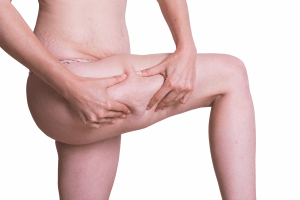Treating Saddlebags

Saddlebags are the pads of fat that develop on the outer thigh area. They can feel hard and fibrous or soft and dough like.
Cellulite can often develop over the fat pad too, worsening their appearance. Women are more likely to have saddlebags than men.
The development of saddlebags is often down to genetic disposition but can also become larger during pregnancy as your body increases its maternal fat stores. Saddlebags are often extremely resistant to exercise.
Factors to Consider

Dehydration
Dehydration plays a large role in the body storing excess water. This water retention can lead to your body appear larger than it is, especially around the thigh area.

Lifestyle
An unhealthy diet, high in calories, carbohydrate and sugar diet can increase the amount of fat stored around the saddlebags. The active fat storage enzymes in this area will store unwanted extra calories in the hip and thigh area.

Hormones
Many women are predisposed to gaining fat around the buttocks and thigh area. And Saddlebags can be more prominent especially with women who are more “pear-shaped”. The cause of this is down to female hormones and genetics. If your close female relatives have saddlebags, it’s most likely you will too. Saddlebags can start to develop during the teenage years as hormones increase.
Treatments for Saddle Bags
We offer two different treatments to improve Saddle Bags. Depending on your individual concerns you may require a combination of these treatments to achieve the best results.

BTL EXILIS ULTRA 360
The first and only device to simultaneously combine radio frequency & ultrasound to tighten skin and address body concerns from head to toe

ULTRASOUND CAVITATION
Ultrasound Cavitation breaks down and shrinks fat cells in the Saddle Bag area. The fat cells are disrupted and the ultrasound causes a vibration deep in the tissues that cause the fat cells to disburse. This, in turn, causes a shrinking of the overall area. A course of 8 treatments is recommended for best results.



